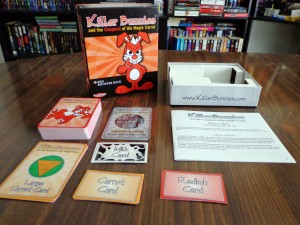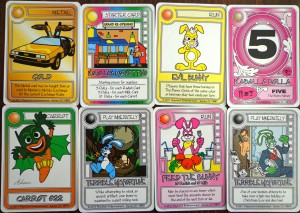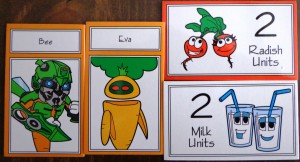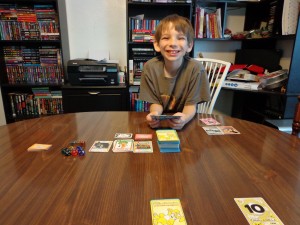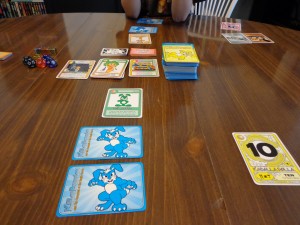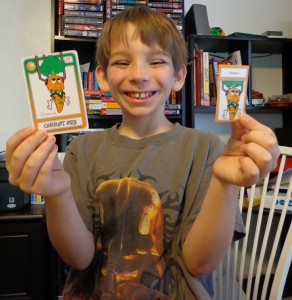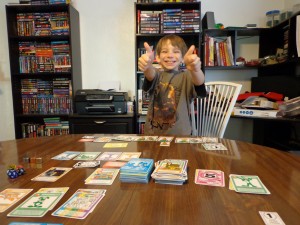Bunnies. They’re cute. They’re fluffy. Everyone loves them…that is…until they begin knocking each other off to pursue the ultimate prize: the Magic Carrot.
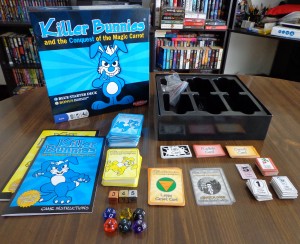
Killer Bunnies and the Conquest of the Magic Carrot: 2-8 Players, Ages 13+, Average Play Time = 45 Minutes
Killer Bunnies and the Conquest of the Magic Carrot tasks players with keeping their bunnies alive, all the while eliminating their opponents’ bunnies and collecting carrots. One of those carrots will end up being the Magic Carrot, giving its owner the “sweet” taste of victory.
This particular game is a follow-up of its predecessor, Killer Bunnies and the Quest for the Magic Carrot. Both versions play similarly, but have some small differences. Both games have their own set of booster packs to add variety to their base games, though the Killer Bunnies website mentions that both versions are compatible with each other, should you want to mix and match.
Before we take a look at the game any further, I’d like to thank Playroom Entertainment for sending me a free copy of the base game of “Conquest” along with its red booster pack for me to review. There’s currently a Kickstarter project in the works that is a Deluxe Edition and includes “Quest” and all of its boosters in one box…if you like what you see here, feel free to support it via the links at the end of this article!
Components
Small Cards – Small cards consist of Carrot cards, Radish cards, and Milk cards.
Large Cards – Large cards consist of Truculent Bunny cards (Blue & Yellow), Large Carrot cards (Orange), and Starter cards (Gray).
Dice – These six-sided dice are colored to represent copper, silver, and gold. They are rolled during the game to indicate the going rate for selling these metals for KABALLA DOLLA (Bunny Money). The twelve-sided dice are used when certain cards are played.
Setup
Shuffle all of the decks (except for the two starter cards) separately. Set the Radish, Milk, and Truculent Bunny cards face down in the middle of the table. The large Carrot and Starter cards are placed face up, and the small Carrot cards are placed off to the side. The dice are placed in the center of the table, along with the main congregation of cards. The six-sided dice are rolled to set the exchange rate for the three metals in the game.
Each player gets seven cards from the Truculent Bunny draw pile. Any “KABALLA DOLLA” or “METAL” cards are placed in front of their owners on the table and replacement cards are drawn. Any “PLAY IMMEDIATELY” cards (which call for the death of a bunny) are discarded and replacement cards are drawn. All players should only have “RUN”, “SPECIAL”, or “VERY SPECIAL” cards in their hands.
Gameplay
The game begins by players choosing which two cards to play over the next two rounds. The first card they choose will be placed face down in front of them and be known as the “Top Run” card. The second card they choose will be placed underneath, face down, and be known as the “Bottom Run” card.
Note: All players should place a Bunny card as their Top Run card. If the player doesn’t have one, they can look at the draw deck and take one. They must then put one of the cards from their hand back into the deck.
Players then roll dice to see who goes first. On a player’s turn, they will do the following:
1. Flip over the Top Run card and slide it up slightly towards the middle of the table.
2. Slide the Bottom Run card up to where the Top Run card was.
3. Draw a card from the Truculent Bunny draw deck.
4. Replace the Bottom Run card with a card from their hand.
As players perform the above, the top-most card(s) will be part of the “Bunny Circle” and are considered “in play”. Players will be adding bunnies to this Bunny Circle and must endeavour to keep them there for game end purposes, which I’ll cover in a minute.
To sum it up, players will be adding cards to their run, which eventually enter the in play “Bunny Circle.” These cards allow players to put bunnies into play or perform various actions. Players will be trying to collect as many Carrot cards as they can, as one of them is the Magic Carrot. Players won’t know which one the Magic Carrot is until the game ends.
Editor’s Note: Think of it as a 50/50 raffle, the more tickets / carrots you have, the better your chances of winning.
The game ends when the last Large Carrot card is purchased (or taken) from the market. Anyone who doesn’t have a bunny in play automatically loses and gives their Large Carrot cards to the person with the most KABALLA DOLLA. Finally, the bottom card of the small Carrot card deck is revealed…the picture shown will match one of the Large Carrot cards owned by players. The person with the matching picture wins the game!
The above is simply an overview of the game. If you’d like to learn more about the game in detail, please check out the manual by clicking the below link:
Killer Bunnies and the Conquest of the Magic Carrot Manual
The Review
The first thing I noticed about the base game was that the cards were incredibly eye-catching. The bright colors allowed me to see at a glance what everyone else had in play, a plus for people who strain their eyes to see across far distances. The colors of the draw deck’s card backs also serve well in separating the expansions from each other and from the base game…allowing players to switch out expansions with ease. The box itself is large enough to hold more decks as you purchase them, which is a nice touch. It is obvious that a lot of thought went into making this game as it is very easy to set up and play.
There is a bit of luck involved, seeing as how the players require certain cards to collect carrots and place bunnies into play. It’s possible for an unlucky individual not to draw bunnies while playing or to be hit with a lot of weapon cards, spelling their doom when the game’s end comes around…though it is a rare event and luck can work both ways.
The game wasn’t hard to teach…in fact it took me less than twenty minutes to teach the eleven year old how to play. However, I must admit I was a little overwhelmed at first with all of the cards and play mechanics when trying to initially teach myself. While the verbal rules primer I gave were fairly sufficient, a few rounds in-game were needed so that we could physically see how the Run cards eventually became part of the Bunny Circle. Understanding the game comes easier after the first few playthrus, so try not to get frustrated on your first few games.
Vinnie (11) and I played using the blue and yellow cards (the base game and the expansion it came with) and had a pretty good time with it. I was enjoying the pop-culture references while he was just having fun with the artwork and card mechanics. He laughed out loud at the Eva Carrot card but asked me who the California Raisins were…I guess I’m getting old and thus should start applying for Social Security. Our first game took over an hour, as we were still trying to get used to the play mechanics. We underestimated the importance of buying up radish and milk cards, and when one or the other would play a “Feed the Bunny” card, we found that we didn’t have the food necessary to keep it alive. This added a bit of strategy as we had to split our money between carrots and food, but we both went about that balance differently.
This game is great for casual players who are more interested in socializing with one another as opposed to being competitive. Competitive players will suck the fun right out of this game. Those going into the game expecting a light, fun card game that will allow them to just spend time with their friends and family won’t be disappointed.
A word to existing “Quest” owners:
For those of you who already own “Quest”, I did a little research by comparing manuals to see how different the two games are. The water and cabbage cards in “Quest” function the same way as radish and milk cards do in “Conquest”. “Conquest” includes a metal market and “Quest” does not, but a lot of the other cards from “Conquest” function like their predecessors, just with different artwork. Existing “Quest” owners who want / need the expansions may want to check out the Deluxe version on Kickstarter via the link below, but be advised that this Deluxe version does not include “Conquest.”
Ultimately, existing “Quest” owners will have to decide on what versions are worth purchasing, and this preference will change from individual to individual. It’s worth noting that all three versions (“Quest”, “Conquest”, and “Deluxe”) can be mixed and matched, allowing players to customize the game to their satisfaction. Is owning two or all three versions worth it? The honest question you’ll have to ask yourself is, “How often do I really play, Killer Bunnies?”
Final Verdict: 7/10
—
You can find more information about the game and its many expansions by visiting the Killer Bunnies website and BoardGameGeek here:
Killer Bunnies – Official Page
Killer Bunnies – BoardGameGeek
You can read about and support the Killer Bunnies Deluxe Edition on Kickstarter here:
Killer Bunnies Deluxe Edition – Kickstarter

